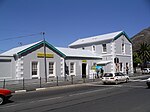HMS Pelorus (J291)

HMS Pelorus (pennant number: J291) was an Algerine-class minesweeper built for the Royal Navy (RN) during World War II. Upon completion, the ship became the flotilla leader of the 7th Minesweeper Flotilla, clearing mines off the east coast of England. In June 1944, the flotilla was assigned to sweep one of the beaches during the Normandy landings until she struck a mine the following month. After her repairs were completed, Pelorus was reassigned to the English Channel and the 6th Minesweeping Flotilla. The flotilla was transferred to the Indian Ocean in 1945 and spent some time escorting convoys. They participated in Operation Collie, a bombardment of Japanese positions in the Nicobar Islands, in July and then swept the Strait of Malacca and the approaches to Singapore in August. After the war, she was sold to the South African Navy and renamed HMSAS Pietermaritzburg. The ship was later converted into a midshipmans' training ship during the early 1960s. She served as a barracks ship from 1968 to 1991 when Pietermaritzburg was listed for disposal. The ship was scuttled as an artificial reef off the South African coast in 1994.
Excerpt from the Wikipedia article HMS Pelorus (J291) (License: CC BY-SA 3.0, Authors, Images).HMS Pelorus (J291)
Main Road,
Geographical coordinates (GPS) Address Nearby Places Show on map
Geographical coordinates (GPS)
| Latitude | Longitude |
|---|---|
| N -34.22 ° | E 18.47 ° |
Address
Main Road
Main Road
7995 , The Boulders
Western Cape, South Africa
Open on Google Maps










